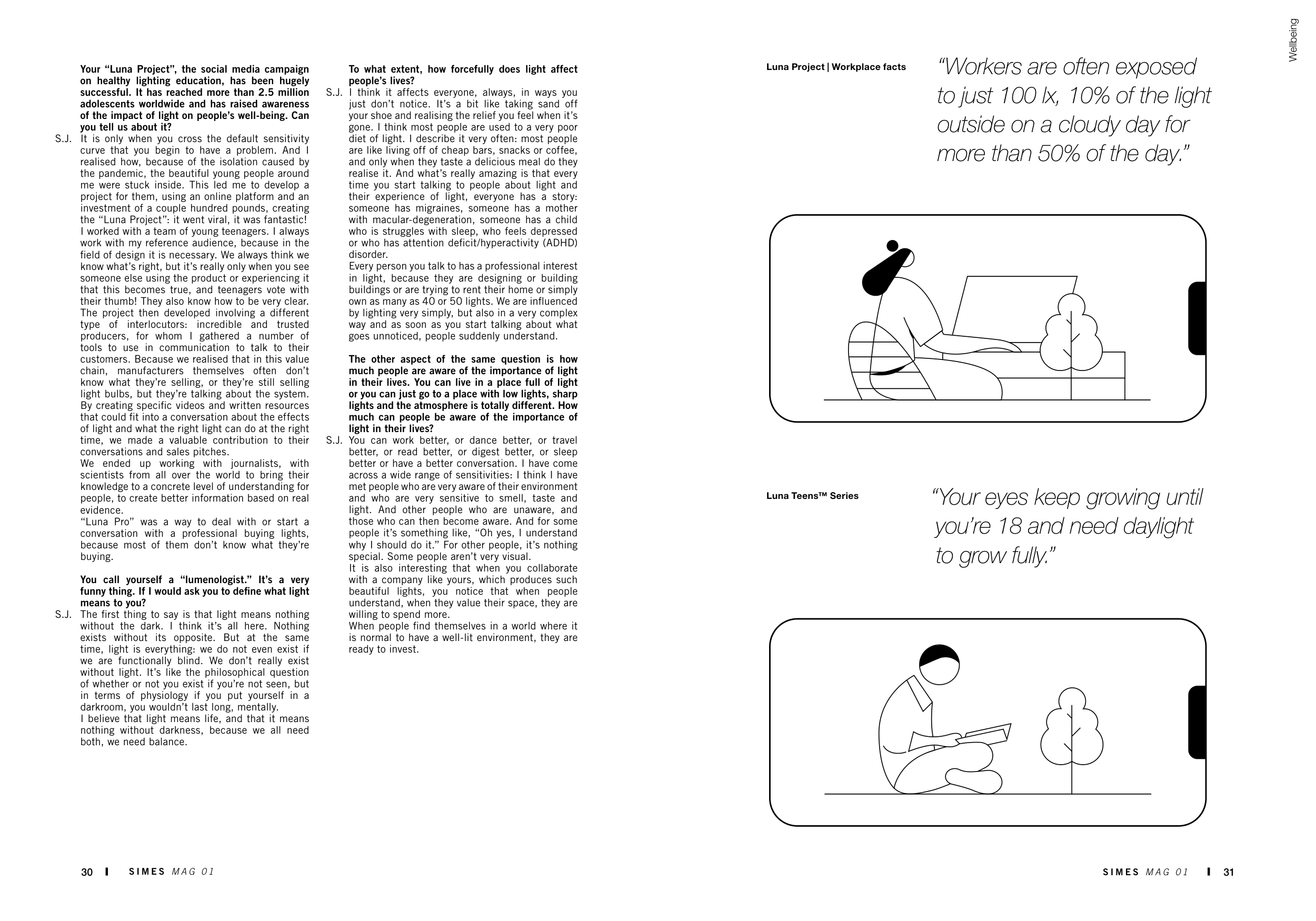Wellbeing
Your “Luna Project”, the social media campaign
on healthy lighting education, has been hugely
successful. It has reached more than 2.5 million
adolescents worldwide and has raised awareness
of the impact of light on people’s well-being. Can
you tell us about it?
It is only when you cross the default sensitivity
curve that you begin to have a problem. And I
realised how, because of the isolation caused by
the pandemic, the beautiful young people around
me were stuck inside. This led me to develop a
project for them, using an online platform and an
investment of a couple hundred pounds, creating
the “Luna Project”: it went viral, it was fantastic!
I worked with a team of young teenagers. I always
work with my reference audience, because in the
field of design it is necessary. We always think we
know what’s right, but it’s really only when you see
someone else using the product or experiencing it
that this becomes true, and teenagers vote with
their thumb! They also know how to be very clear.
The project then developed involving a different
type of interlocutors: incredible and trusted
producers, for whom I gathered a number of
tools to use in communication to talk to their
customers. Because we realised that in this value
chain, manufacturers themselves often don’t
know what they’re selling, or they’re still selling
light bulbs, but they’re talking about the system.
By creating specific videos and written resources
that could fit into a conversation about the effects
of light and what the right light can do at the right
time, we made a valuable contribution to their
conversations and sales pitches.
We ended up working with journalists, with
scientists from all over the world to bring their
knowledge to a concrete level of understanding for
people, to create better information based on real
evidence.
“Luna Pro” was a way to deal with or start a
conversation with a professional buying lights,
because most of them don’t know what they’re
buying.
You call yourself a “lumenologist.” It’s a very
funny thing. If I would ask you to define what light
means to you?
The first thing to say is that light means nothing
without the dark. I think it’s all here. Nothing
exists without its opposite. But at the same
time, light is everything: we do not even exist if
we are functionally blind. We don’t really exist
without light. It’s like the philosophical question
of whether or not you exist if you’re not seen, but
in terms of physiology if you put yourself in a
darkroom, you wouldn’t last long, mentally.
I believe that light means life, and that it means
nothing without darkness, because we all need
both, we need balance.
S.J.
S.J.
To what extent, how forcefully does light affect
people’s lives?
I think it affects everyone, always, in ways you
just don’t notice. It’s a bit like taking sand off
your shoe and realising the relief you feel when it’s
gone. I think most people are used to a very poor
diet of light. I describe it very often: most people
are like living off of cheap bars, snacks or coffee,
and only when they taste a delicious meal do they
realise it. And what’s really amazing is that every
time you start talking to people about light and
their experience of light, everyone has a story:
someone has migraines, someone has a mother
with macular-degeneration, someone has a child
who is struggles with sleep, who feels depressed
or who has attention deficit/hyperactivity (ADHD)
disorder.
Every person you talk to has a professional interest
in light, because they are designing or building
buildings or are trying to rent their home or simply
own as many as 40 or 50 lights. We are influenced
by lighting very simply, but also in a very complex
way and as soon as you start talking about what
goes unnoticed, people suddenly understand.
The other aspect of the same question is how
much people are aware of the importance of light
in their lives. You can live in a place full of light
or you can just go to a place with low lights, sharp
lights and the atmosphere is totally different. How
much can people be aware of the importance of
light in their lives?
You can work better, or dance better, or travel
better, or read better, or digest better, or sleep
better or have a better conversation. I have come
across a wide range of sensitivities: I think I have
met people who are very aware of their environment
and who are very sensitive to smell, taste and
light. And other people who are unaware, and
those who can then become aware. And for some
people it’s something like, “Oh yes, I understand
why I should do it.” For other people, it’s nothing
special. Some people aren’t very visual.
It is also interesting that when you collaborate
with a company like yours, which produces such
beautiful lights, you notice that when people
understand, when they value their space, they are
willing to spend more.
When people find themselves in a world where it
is normal to have a well-lit environment, they are
ready to invest.
S.J.
S.J.
“Your eyes keep growing until
you’re 18 and need daylight
to grow fully.”
Luna Project | Workplace facts
Luna Teens™ Series
“Workers are often exposed
to just 100 lx, 10% of the light
outside on a cloudy day for
more than 50% of the day.”
30
31
S I M E S M A G 0 1
S I M E S M A G 0 1


